child lock CADILLAC ESCALADE 2007 3.G Owners Manual
[x] Cancel search | Manufacturer: CADILLAC, Model Year: 2007, Model line: ESCALADE, Model: CADILLAC ESCALADE 2007 3.GPages: 574, PDF Size: 2.89 MB
Page 1 of 574
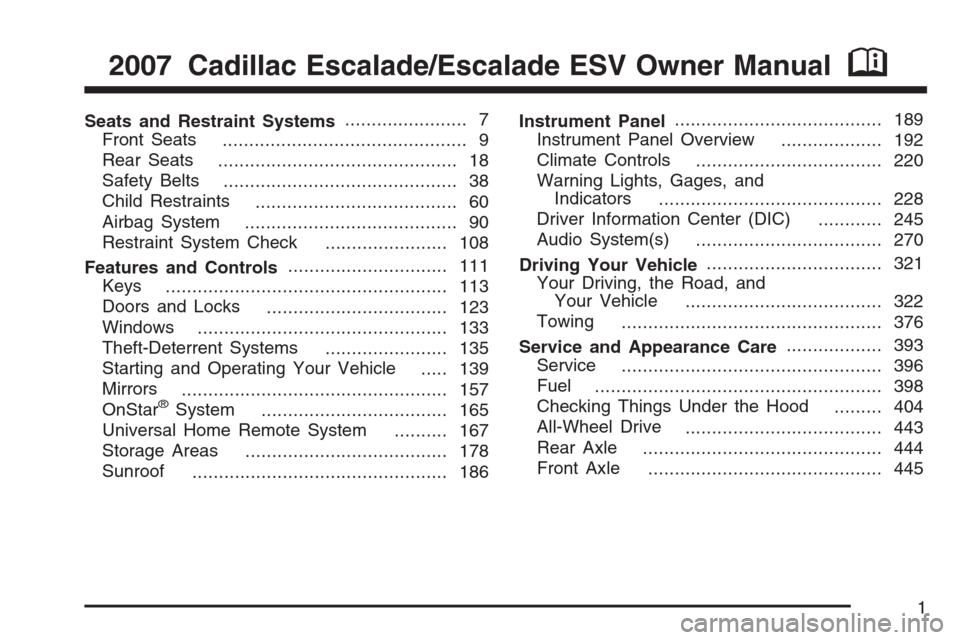
Seats and Restraint Systems....................... 7
Front Seats
.............................................. 9
Rear Seats
............................................. 18
Safety Belts
............................................ 38
Child Restraints
...................................... 60
Airbag System
........................................ 90
Restraint System Check
....................... 108
Features and Controls.............................. 111
Keys
..................................................... 113
Doors and Locks
.................................. 123
Windows
............................................... 133
Theft-Deterrent Systems
....................... 135
Starting and Operating Your Vehicle
..... 139
Mirrors
.................................................. 157
OnStar
®System
................................... 165
Universal Home Remote System
.......... 167
Storage Areas
...................................... 178
Sunroof
................................................ 186Instrument Panel....................................... 189
Instrument Panel Overview
................... 192
Climate Controls
................................... 220
Warning Lights, Gages, and
Indicators
.......................................... 228
Driver Information Center (DIC)
............ 245
Audio System(s)
................................... 270
Driving Your Vehicle................................. 321
Your Driving, the Road, and
Your Vehicle
..................................... 322
Towing
................................................. 376
Service and Appearance Care.................. 393
Service
................................................. 396
Fuel
...................................................... 398
Checking Things Under the Hood
......... 404
All-Wheel Drive
..................................... 443
Rear Axle
............................................. 444
Front Axle
............................................ 445
2007 Cadillac Escalade/Escalade ESV Owner ManualM
1
Page 43 of 574
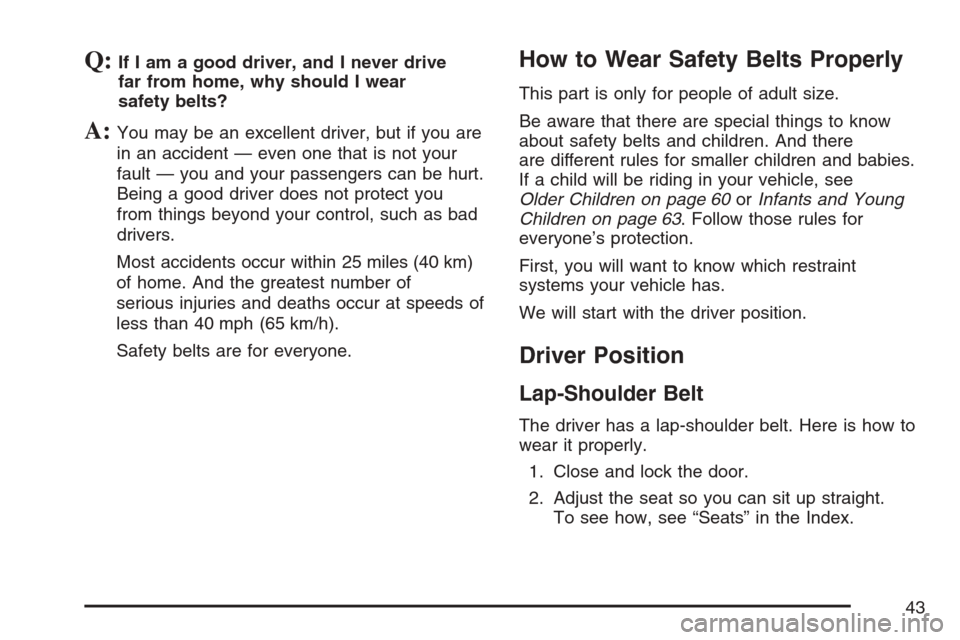
Q:If I am a good driver, and I never drive
far from home, why should I wear
safety belts?
A:You may be an excellent driver, but if you are
in an accident — even one that is not your
fault — you and your passengers can be hurt.
Being a good driver does not protect you
from things beyond your control, such as bad
drivers.
Most accidents occur within 25 miles (40 km)
of home. And the greatest number of
serious injuries and deaths occur at speeds of
less than 40 mph (65 km/h).
Safety belts are for everyone.
How to Wear Safety Belts Properly
This part is only for people of adult size.
Be aware that there are special things to know
about safety belts and children. And there
are different rules for smaller children and babies.
If a child will be riding in your vehicle, see
Older Children on page 60orInfants and Young
Children on page 63. Follow those rules for
everyone’s protection.
First, you will want to know which restraint
systems your vehicle has.
We will start with the driver position.
Driver Position
Lap-Shoulder Belt
The driver has a lap-shoulder belt. Here is how to
wear it properly.
1. Close and lock the door.
2. Adjust the seat so you can sit up straight.
To see how, see “Seats” in the Index.
43
Page 51 of 574
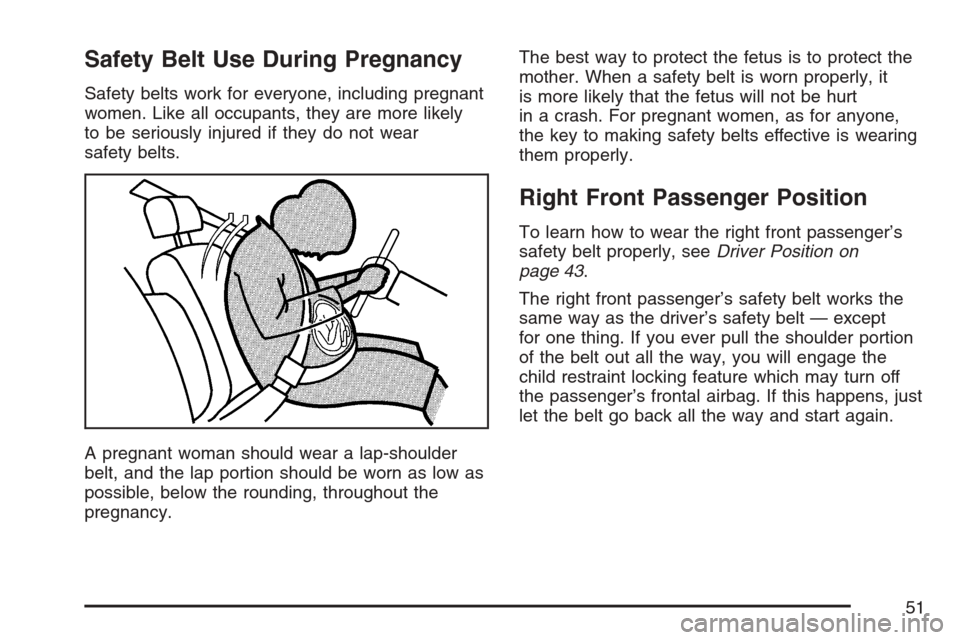
Safety Belt Use During Pregnancy
Safety belts work for everyone, including pregnant
women. Like all occupants, they are more likely
to be seriously injured if they do not wear
safety belts.
A pregnant woman should wear a lap-shoulder
belt, and the lap portion should be worn as low as
possible, below the rounding, throughout the
pregnancy.The best way to protect the fetus is to protect the
mother. When a safety belt is worn properly, it
is more likely that the fetus will not be hurt
in a crash. For pregnant women, as for anyone,
the key to making safety belts effective is wearing
them properly.
Right Front Passenger Position
To learn how to wear the right front passenger’s
safety belt properly, seeDriver Position on
page 43.
The right front passenger’s safety belt works the
same way as the driver’s safety belt — except
for one thing. If you ever pull the shoulder portion
of the belt out all the way, you will engage the
child restraint locking feature which may turn off
the passenger’s frontal airbag. If this happens, just
let the belt go back all the way and start again.
51
Page 80 of 574
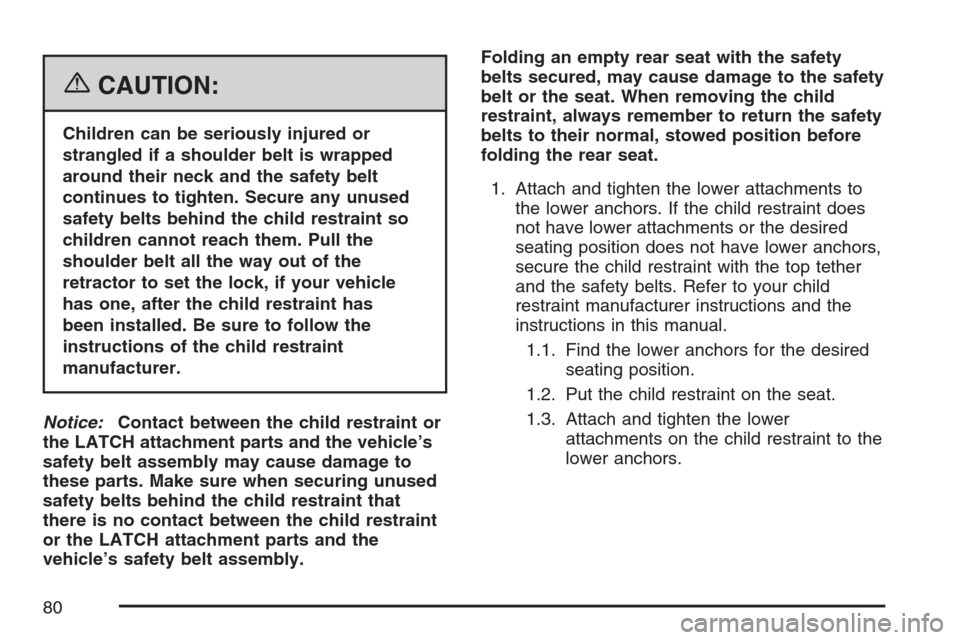
{CAUTION:
Children can be seriously injured or
strangled if a shoulder belt is wrapped
around their neck and the safety belt
continues to tighten. Secure any unused
safety belts behind the child restraint so
children cannot reach them. Pull the
shoulder belt all the way out of the
retractor to set the lock, if your vehicle
has one, after the child restraint has
been installed. Be sure to follow the
instructions of the child restraint
manufacturer.
Notice:Contact between the child restraint or
the LATCH attachment parts and the vehicle’s
safety belt assembly may cause damage to
these parts. Make sure when securing unused
safety belts behind the child restraint that
there is no contact between the child restraint
or the LATCH attachment parts and the
vehicle’s safety belt assembly.Folding an empty rear seat with the safety
belts secured, may cause damage to the safety
belt or the seat. When removing the child
restraint, always remember to return the safety
belts to their normal, stowed position before
folding the rear seat.
1. Attach and tighten the lower attachments to
the lower anchors. If the child restraint does
not have lower attachments or the desired
seating position does not have lower anchors,
secure the child restraint with the top tether
and the safety belts. Refer to your child
restraint manufacturer instructions and the
instructions in this manual.
1.1. Find the lower anchors for the desired
seating position.
1.2. Put the child restraint on the seat.
1.3. Attach and tighten the lower
attachments on the child restraint to the
lower anchors.
80
Page 84 of 574
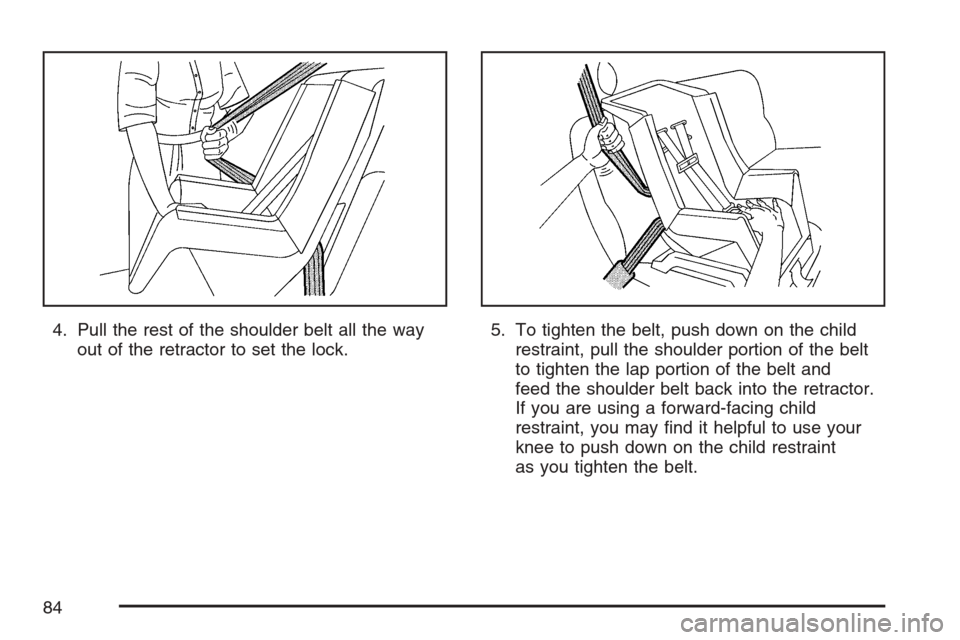
4. Pull the rest of the shoulder belt all the way
out of the retractor to set the lock.5. To tighten the belt, push down on the child
restraint, pull the shoulder portion of the belt
to tighten the lap portion of the belt and
feed the shoulder belt back into the retractor.
If you are using a forward-facing child
restraint, you may �nd it helpful to use your
knee to push down on the child restraint
as you tighten the belt.
84
Page 89 of 574
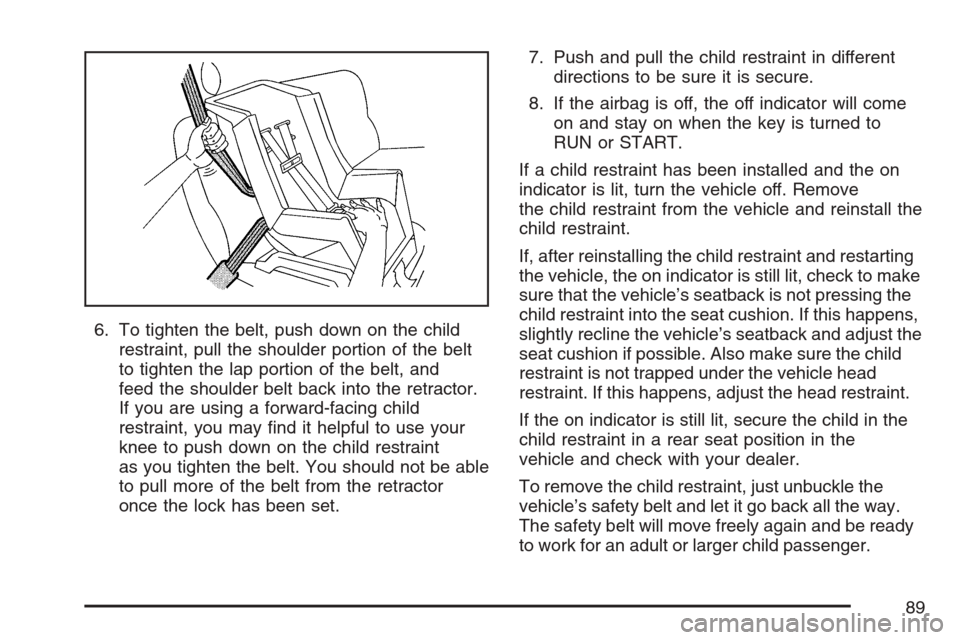
6. To tighten the belt, push down on the child
restraint, pull the shoulder portion of the belt
to tighten the lap portion of the belt, and
feed the shoulder belt back into the retractor.
If you are using a forward-facing child
restraint, you may �nd it helpful to use your
knee to push down on the child restraint
as you tighten the belt. You should not be able
to pull more of the belt from the retractor
once the lock has been set.7. Push and pull the child restraint in different
directions to be sure it is secure.
8. If the airbag is off, the off indicator will come
on and stay on when the key is turned to
RUN or START.
If a child restraint has been installed and the on
indicator is lit, turn the vehicle off. Remove
the child restraint from the vehicle and reinstall the
child restraint.
If, after reinstalling the child restraint and restarting
the vehicle, the on indicator is still lit, check to make
sure that the vehicle’s seatback is not pressing the
child restraint into the seat cushion. If this happens,
slightly recline the vehicle’s seatback and adjust the
seat cushion if possible. Also make sure the child
restraint is not trapped under the vehicle head
restraint. If this happens, adjust the head restraint.
If the on indicator is still lit, secure the child in the
child restraint in a rear seat position in the
vehicle and check with your dealer.
To remove the child restraint, just unbuckle the
vehicle’s safety belt and let it go back all the way.
The safety belt will move freely again and be ready
to work for an adult or larger child passenger.
89
Page 123 of 574
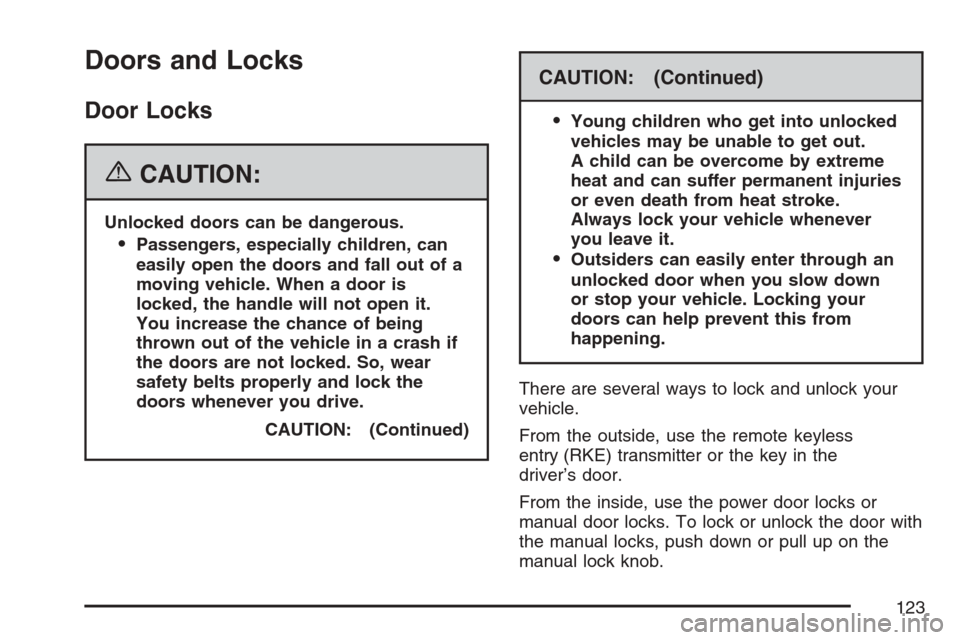
Doors and Locks
Door Locks
{CAUTION:
Unlocked doors can be dangerous.
Passengers, especially children, can
easily open the doors and fall out of a
moving vehicle. When a door is
locked, the handle will not open it.
You increase the chance of being
thrown out of the vehicle in a crash if
the doors are not locked. So, wear
safety belts properly and lock the
doors whenever you drive.
CAUTION: (Continued)
CAUTION: (Continued)
Young children who get into unlocked
vehicles may be unable to get out.
A child can be overcome by extreme
heat and can suffer permanent injuries
or even death from heat stroke.
Always lock your vehicle whenever
you leave it.
Outsiders can easily enter through an
unlocked door when you slow down
or stop your vehicle. Locking your
doors can help prevent this from
happening.
There are several ways to lock and unlock your
vehicle.
From the outside, use the remote keyless
entry (RKE) transmitter or the key in the
driver’s door.
From the inside, use the power door locks or
manual door locks. To lock or unlock the door with
the manual locks, push down or pull up on the
manual lock knob.
123
Page 334 of 574

If you need to reduce your speed as you approach
a curve, do it before you enter the curve, while
your front wheels are straight ahead.
Try to adjust your speed so you can “drive”
through the curve. Maintain a reasonable, steady
speed. Wait to accelerate until you are out of
the curve, and then accelerate gently into
the straightaway.
Adding non-GM accessories can affect your
vehicle’s performance. SeeAccessories and
Modi�cations on page 396.
Steering in Emergencies
There are times when steering can be more
effective than braking. For example, you come
over a hill and �nd a truck stopped in your lane,
or a car suddenly pulls out from nowhere, or
a child darts out from between parked cars and
stops right in front of you. You can avoid
these problems by braking — if you can stop in
time. But sometimes you cannot; there is not room.
That is the time for evasive action — steering
around the problem.
Your vehicle can perform very well in emergencies
like these. First apply your brakes.SeeBraking on page 326. It is better to remove as
much speed as you can from a possible collision.
Then steer around the problem, to the left or
right depending on the space available.
An emergency like this requires close attention and
a quick decision. If you are holding the steering
wheel at the recommended 9 and 3 o’clock
positions, you can turn it a full 180 degrees very
quickly without removing either hand. But you
have to act fast, steer quickly, and just as quickly
straighten the wheel once you have avoided
the object.
334
Page 401 of 574
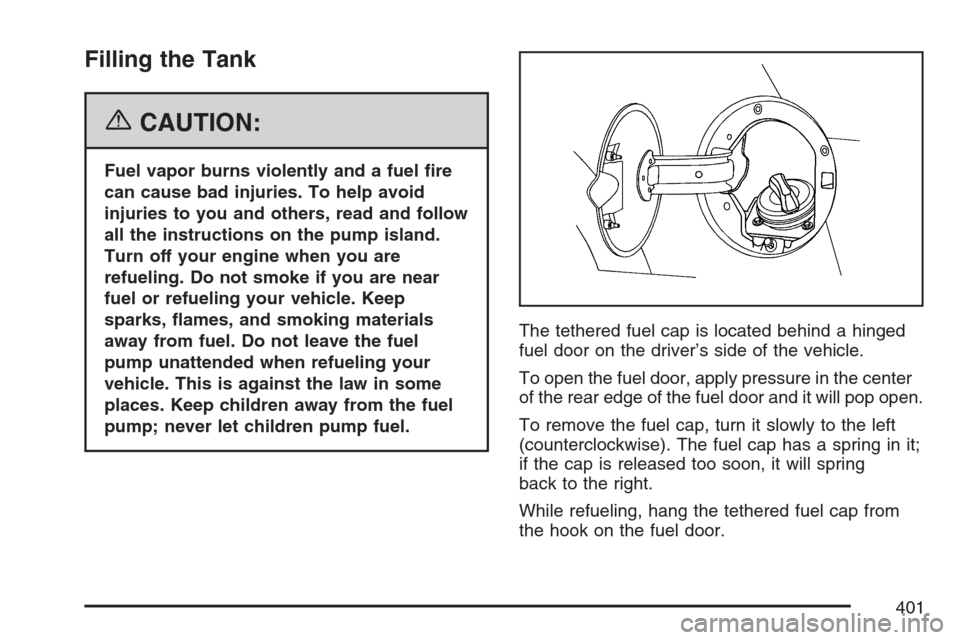
Filling the Tank
{CAUTION:
Fuel vapor burns violently and a fuel �re
can cause bad injuries. To help avoid
injuries to you and others, read and follow
all the instructions on the pump island.
Turn off your engine when you are
refueling. Do not smoke if you are near
fuel or refueling your vehicle. Keep
sparks, �ames, and smoking materials
away from fuel. Do not leave the fuel
pump unattended when refueling your
vehicle. This is against the law in some
places. Keep children away from the fuel
pump; never let children pump fuel.The tethered fuel cap is located behind a hinged
fuel door on the driver’s side of the vehicle.
To open the fuel door, apply pressure in the center
of the rear edge of the fuel door and it will pop open.
To remove the fuel cap, turn it slowly to the left
(counterclockwise). The fuel cap has a spring in it;
if the cap is released too soon, it will spring
back to the right.
While refueling, hang the tethered fuel cap from
the hook on the fuel door.
401
Page 566 of 574

L
Labeling, Tire Sidewall................................. 455
Lamps
Battery Run-Down Protection................... 213
Dome....................................................... 212
Dome Lamp Override............................... 213
Exterior.................................................... 205
Fog .......................................................... 212
Reading................................................... 213
LATCH System
Child Restraints......................................... 73
License Plate Lamps................................... 451
Liftgate, Power............................................ 128
Liftgate/Liftglass........................................... 126
Liftglass/Liftgate........................................... 126
Light
Airbag Readiness..................................... 232
Anti-Lock Brake System Warning............. 237
Brake System Warning............................. 235
Charging System..................................... 235
Cruise Control.......................................... 243
Fog Lamp................................................ 243
Highbeam On.......................................... 243
Lights On Reminder................................. 243
Malfunction Indicator................................ 239Light (cont.)
Oil Pressure............................................. 242
Passenger Airbag Status Indicator............ 233
Passenger Safety Belt Reminder.............. 231
Safety Belt Reminder............................... 231
Security................................................... 242
StabiliTrak
®Indicator................................ 237
Tire Pressure........................................... 238
Tow/Haul Mode........................................ 244
Lighting
Entry........................................................ 213
Exit.......................................................... 213
Loading Your Vehicle................................... 370
Locking Differential...................................... 329
Lockout Protection....................................... 125
Locks
Delayed Locking...................................... 124
Door........................................................ 123
Lockout Protection................................... 125
Power Door............................................. 124
Programmable Automatic Door Locks....... 124
Rear Door Security Locks........................ 124
Loss of Control........................................... 337
Luggage Carrier.......................................... 179
Lumbar
Power Controls.......................................... 10
566